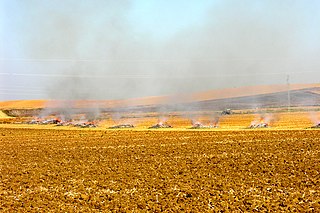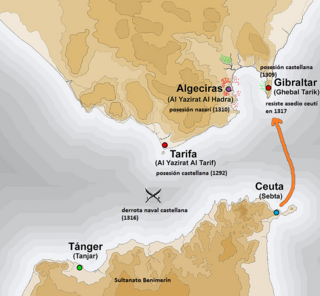
Granada is the capital city of the province of Granada, in the autonomous community of Andalusia, Spain. Granada is located at the foot of the Sierra Nevada mountains, at the confluence of four rivers, the Darro, the Genil, the Monachil and the Beiro. Ascribed to the Vega de Granada comarca, the city sits at an average elevation of 738 m (2,421 ft) above sea level, yet is only one hour by car from the Mediterranean coast, the Costa Tropical. Nearby is the Sierra Nevada Ski Station, where the FIS Alpine World Ski Championships 1996 were held.

Alfonso XI, called the Avenger, was King of Castile and León. He was the son of Ferdinand IV of Castile and his wife Constance of Portugal. Upon his father's death in 1312, several disputes ensued over who would hold regency, which were resolved in 1313.

The Battle of La Higueruela was fought in the vega of the river Genil near Granada on 1 July 1431 between the forces of John II of Castile, led by Álvaro de Luna, and troops loyal to Muhammed IX, Nasrid Sultan of Granada. The battle was a modest victory for the forces of Castile, with no territorial gain and failing to take Granada. Following this battle, John II of Castile installed Yusuf IV, grandson of Muhammed VI, as Sultan of Granada.
Muhammad II was the second Nasrid ruler of the Emirate of Granada in Al-Andalus on the Iberian Peninsula, succeeding his father, Muhammad I. Already experienced in matters of state when he ascended the throne, he continued his father's policy of maintaining independence in the face of Granada's larger neighbours, the Christian kingdom of Castile and the Muslim Marinid state of Morocco, as well as an internal rebellion by his family's former allies, the Banu Ashqilula.
Nasr, full name Abu al-Juyush Nasr ibn Muhammad, was the fourth Nasrid ruler of the Emirate of Granada from 14 March 1309 until his abdication on 8 February 1314. He was the son of Muhammad II al-Faqih and Shams al-Duha. He ascended the throne after his brother Muhammad III was dethroned in a palace revolution. At the time of his accession, Granada faced a three-front war against Castile, Aragon and the Marinid Sultanate, triggered by his predecessor's foreign policy. He made peace with the Marinids in September 1309, ceding to them the African port of Ceuta, which had already been captured, as well as Algeciras and Ronda in Europe. Granada lost Gibraltar to a Castilian siege in September, but successfully defended Algeciras until it was given to the Marinids, who continued its defense until the siege was abandoned in January 1310. James II of Aragon sued for peace after Granadan defenders defeated the Aragonese siege of Almería in December 1309, withdrawing his forces and leaving the Emirate's territories by January. In the ensuing treaty, Nasr agreed to pay tributes and indemnities to Ferdinand IV of Castile and yield some border towns in exchange for seven years of peace.
Abu'l-Walid Ismail I ibn Faraj was the fifth Nasrid ruler of the Emirate of Granada on the Iberian Peninsula from 1314 to 1325. A grandson of Muhammad II on the side of his mother Fatima, he was the first of the lineage of sultans now known as the al-dawla al-isma'iliyya al-nasriyya. Historians characterise him as an effective ruler who improved the emirate's position with military victories during his reign.

The Emirate of Granada, also known as the Nasrid Kingdom of Granada, was an Islamic realm in the southern Iberian Peninsula during the Late Middle Ages. It was the last independent Muslim state in Western Europe.
Blanche of Castile was by birth a member of the Castilian House of Burgundy. She was the only child of Infante Peter of Castile and Infanta Maria of Aragon.

The Battle of Moclín, also known as the Disaster of Moclín, was a battle fought in the Granadian municipality of Moclín on 23 June 1280. The battle pitted the troops of the Emirate of Granada, commanded by Muhammad II, the Sultan of Granada, against those of the Kingdom of Castile and the Kingdom of León who were composed mainly of mercenaries and of members of the Order of Santiago, being commanded by the contemporary grand master of the order Gonzalo Ruiz Girón and by Sancho, son of King Alfonso X of Castile.
Alfonso Fernández el Niño was a Spanish nobleman, the illegitimate son of King Alfonso X of Castile and Elvira Rodríguez de Villada. He was the lord of Molina and Mesa through his marriage to Blanca Alfonso de Molina, daughter of the infante Alfonso of Molina and niece of King Alfonso IX of León.

The siege of Algeciras was the first of many sieges of the city by Christian forces in the lengthy period of the Spanish Reconquista. The siege, ordered by King Alfonso X of Castile also known as "el Sabio", was a fruitless military campaign initiated by the Kingdom of Castile with the objective of removing the Benimerins from Algeciras. The siege on Algeciras, then known to the Muslims as Al-Jazira Al-Khadra, was strategically important because Algeciras had been at the time the main fortress and landing place for African reinforcement troops in the Iberian Peninsula. Castile, which had a powerful armada of ships anchored in the Bay of Gibraltar to blockade such reinforcement, had a few days previously to the siege, seen that fleet obliterated by the Muslim admiral, Abu Yusuf Yaqub at the Naval Battle of Algeciras.

The Battle of Écija was a battle of the Spanish Reconquista that took place in September 1275. The battle pitted the Muslim troops of the Nasrid Emirate of Granada and its Moroccan allies against those of the Kingdom of Castile and resulted in a victory for the Emirate of Granada.

The second siege of Gibraltar was an abortive attempt in 1316 by the forces of the Azafid Ceuta and the Nasrid Emirate of Granada to recapture Gibraltar, which had fallen to the forces of Ferdinand IV of Castile in 1309.

The Battle of Los Alporchones was a battle of the Spanish Reconquista that took place on 17 March 1452. The battle was fought between the troops of the Emirate of Granada and the combined forces of the Kingdom of Castile and its client kingdom, the Kingdom of Murcia. The Moorish army was commanded by Malik ibn al-Abbas and the Castilian troops were commanded by Alonso Fajardo el Bravo, the head of the House of Fajardo and the Alcalde of Lorca Castle. The battle was fought in the area around the city of Lorca and resulted in a victory for the Kingdom of Castile.

The Battle of Guadix was an engagement between Castilian and Granadan forces at Guadix, then in the Emirate of Granada and now in Spain, that took place in January 1362. The Castilians were routed by forces loyal to Muhammed VI, Sultan of Granada. Despite his victory, Muhammed VI soon after sued for peace. He was murdered on the orders of King Peter of Castile.

The Battle of Martos was a minor battle of the Spanish Reconquista fought between Martos and Torredonjimeno in Andalusia in 1275. The battle was fought between the troops of the Kingdom of Granada and those of the Kingdom of Castile. The Castilian force was completely destroyed as a result of the battle. There is some confusion in the dates since different authors report different dates. Zurita, for example, reports that the events described here took place between May and August; the more modern authors, however, put them between September and October.
Diego Fernández de Córdoba y Mendoza, 3rd Count of Cabra, was a Castilian nobleman. He served with distinction during the war in which the Emirate of Granada was conquered by the forces of Castile and Aragon, and subsequently had great influence in Castile.
Abu Sa'id Uthman ibn Abi al-Ula was a Marinid prince who led an unsuccessful rebellion aiming to capture the throne, and fled to the Nasrid Emirate of Granada in its aftermath. There he served as the Commander of the Volunteers of the Faith of Granada, and became one of the most important political figures of the Nasrid realm.
The Battle of Ceuta (1309) was a military confrontation between the Crown of Aragon and the Nasrid kingdom of Granada in the city of Ceuta during the Castilian-Granadian War from 1309 to 1319. The Benimerin Sultanate wished to occupy the city but lacked a navy to carry out the enterprise. The Crown of Aragon, which had gone to war against the Granada, set out to conquer the city for the Benimerins.











